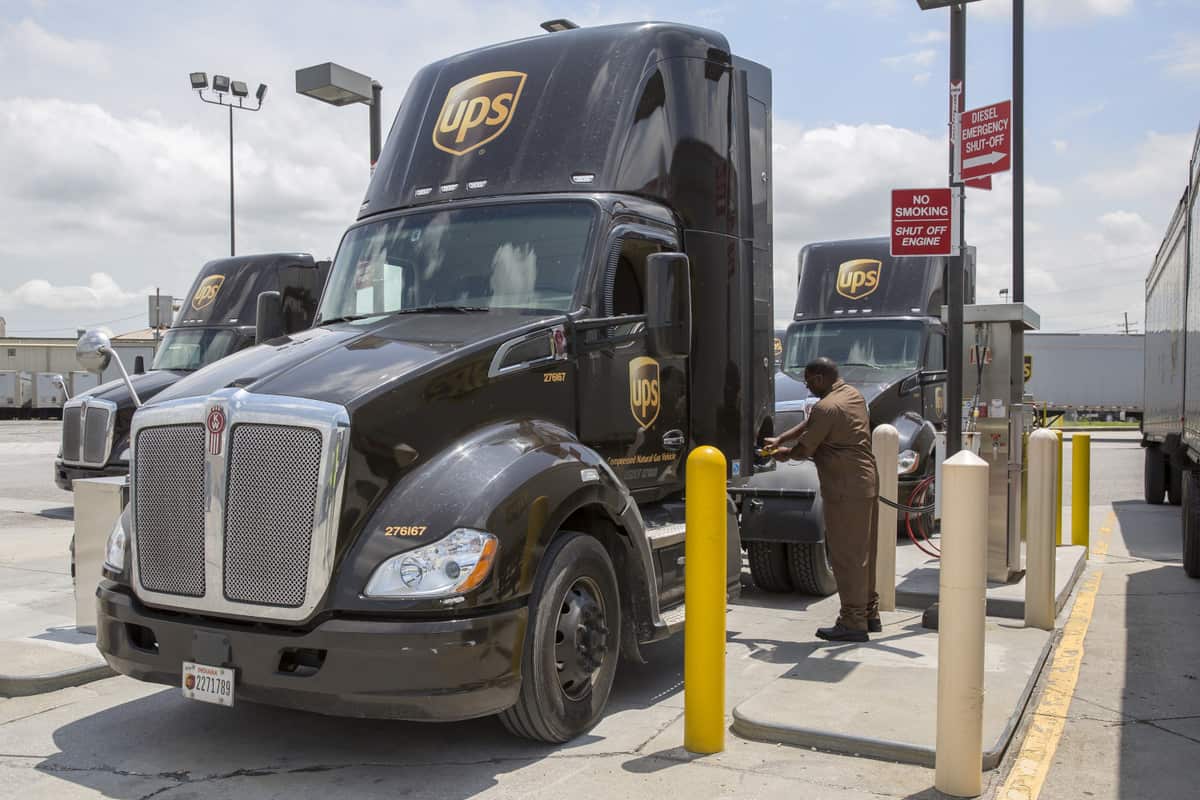Following its decision to purchase 230 million gallon equivalents of renewable natural gas (RNG) to use between 2020 and 2026, UPS (NYSE: UPS) is acquiring vehicles to use the fuel. Big Brown announced on Oct. 9, 2019, that it deploy 6,000 natural-gas powered trucks starting next year as part of a three-year agreement with Agility Fuel Solutions.
Agility has supplied natural gas fuel storage and delivery systems for UPS since 2016, totaling more than 1,700 current UPS trucks. Under terms of the $450-million agreement, Agility “will provide complete end-to-end natural gas systems for heavy-duty gas trucks, terminal tractors and medium-duty walk-in vans,” UPS said in a statement. These will include on-board compressed natural gas (CNG) fuel storage and management and Agility’s certified natural gas engine fuel systems.
“UPS continues to expand and improve our smart logistics network by implementing new technologies and creating a highly flexible, data-driven, and sustainable network,” Juan Perez, chief information and engineering officer for UPS, said. “That is why we intend for 25% of our vehicles purchased in 2020 to run on alternative fuels.”
Vehicles with CNG fuel systems can run either traditional CNG or RNG. Since 2014, UPS ground fleets have consumed 28 million gallons of RNG. UPS’ goal is to reduce greenhouse gas emissions by 12% in its ground fleets by 2025.
In 2018, UPS purchased more than 400 tractors and 330 terminal trucks running on CNG. Kristen Petrella, UPS sustainability public relations manager, said the company has more than 4,200 Class 8 natural gas tractors in its fleet currently, and this announcement will expand on this. While she declined to provide a specific breakdown of the 6,000 vehicles, Petrella said the majority of them will be the familiar brown medium-duty delivery trucks. Vehicles will be sourced from current UPS suppliers.
“As vehicles in UPS’s legacy fleet are retired through normal attrition, removing diesel delivery vehicles is a top priority,” she said. “While in the past, the majority of the diesel delivery vehicles have been replaced with gasoline vehicles, these new 6,000 CNG delivery trucks will now offset a portion of the gasoline replacements.”
The new agreement with Agility is in addition to UPS’s current relationship with TruStar Energy, which is designing, manufacturing, and installing five CNG fueling stations for the company. These are located in Lathrop, Visalia and Moreno Valley, California; Houston, Texas; and Cleveland, Ohio.
By the end of this year, UPS said it will operate 61 natural gas fueling stations throughout the U.S., Canada, and the United Kingdom.
“We are proud to continue our collaboration with UPS, a front-runner in clean transportation,” Seung Baik, president of Agility Fuel Solutions, said. “With our range of proven and reliable clean fuel technologies and aftermarket support capabilities, we will assist UPS in reaching its sustainability targets.”
UPS is not abandoning efforts to develop other fuels. Electric, hybrid-electric and propane vehicles are part of UPS’s 10,000-plus low-emission vehicle fleet. Over the past decade, UPS said it has invested more than $1 billion in alternative fuel and advanced technology vehicles and fueling stations. Vehicles are deployed on routes that make the most sense for the power source.
Natural gas, while not garnering the headlines electric is, remains a viable fuel for fleets in the right applications.
“We work with a lot of fleets that have made significant investments in natural gas because they have figured it out,” Erik Neandross, CEO of Gladstein, Neandross & Associates (GNA), a consulting firm specializing in alternative fuel vehicles and the organizers of ACT Expo, told FreightWaves earlier this year. “UPS is still making a $100 million investment in natural gas each year. UPS doesn’t spend $100 million a year in technology that doesn’t work. So, what have they figured out? They’ve figured out how to make it work for them.”
Natural gas can reduce operational costs by 30% in some applications, Neandross said, and may be a benefactor of the U.S. Environmental Protection Agency’s (EPA) announcement last year that it would revisit and potentially lower oxides of nitrogen (NOx) limits on trucks through its Cleaner Trucks Initiative (CTI). Current NOx levels are set at 0.20 grams per brake horsepower per hour. The California Air Resources Board (CARB) has led a coalition of states and clean air groups in pushing EPA to revise and lower NOx limits, citing technologies that are now available that can further decrease the emissions. CARB has pushed for a 90% reduction in NOx. Interestingly, NGVAmerica, which advocates for natural gas vehicles, said that natural gas Class 8 tractors reduce NOx by 90% compared to today’s diesel engines.
“Natural gas is kind of yesterday’s news; people just don’t get excited about it,” Neandross said. “The price of fuel in 2011, 2012 and 2013, when oil was up at $100-plus a barrel, [made natural gas] very, very motivating. And you would think that the [lower] price of diesel being what it is today would have a proportional negative impact. But frankly, what I see is the interest [remains].”
Navigant Research has previously found that by 2022, nearly 400,000 natural gas-powered trucks and buses would be in operation globally, up from 170,000 in 2013. By comparison, Navigant said there were only 31,000 electric trucks sold globally in 2016, and that figure is expected to rise to just over 100,000 by 2020, with the compound annual growth globally of both medium- and heavy-duty trucks about 9% through 2030.










